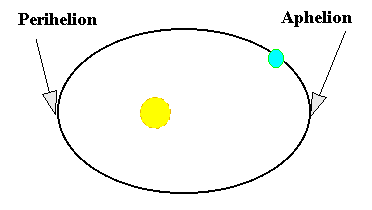
Earth does go around the Sun, but not in a circle. Earth's orbit is an ellipse, a lopsided curve with one end closer to the Sun than the other. On July 7, 2007, our planet is at the distant end--a point astronomers call "aphelion." This puts us farther from the Sun than we are at any other time of year. All planets in our solar system travel around the Sun in elliptical orbits. It's Kepler's 1st Law. The eccentricity of Earth's orbit is 1.7%. In January when we're closest to the Sun (perihelion), the distance is 147.5 million km. In July we're 152.6 million km away--a five million kilometer difference.
A distant sun means less sunlight for our planet. Averaged over the globe, sunlight falling on Earth at aphelion is about 7% less intense than it is at perihelion.
Then why is it so warm outside?

Seasonal weather patterns are shaped primarily by the 23.5 degree tilt of our planet's spin axis, not by aphelion or perihelion. During northern summer the north pole is tilted toward the Sun. The Sun climbs high in the sky, and days are long. That's what makes July so hot.
But there's more to the story: the average temperature of the whole earth at aphelion is about 4 degrees higher than it is at perihelion. Our planet is actually warmer when we're farther from the Sun. Strange but true.
But there's more to the story: the average temperature of the whole earth at aphelion is about 4 degrees higher than it is at perihelion. Our planet is actually warmer when we're farther from the Sun. Strange but true.
This happens because continents and oceans aren't distributed evenly around the globe. There's more land in the northern hemisphere and more water in the south. During the month of July the land-crowded northern half of our planet is tilted toward the Sun. Earth's temperature is slightly higher in July because the Sun is shining down on all that land, which heats up rather easily.
Physicists would say that continents have low heat capacity. Consider the desert. At night the desert is cold, perhaps only 60 F. When the Sun rises in the morning the temperature might jump to 100 F or more." Such mercurial behavior is characteristic of materials like rocks and soil with low heat capacity. It doesn't take much sunlight to substantially elevate their temperature.
Water is different. It has high heat capacity. Let's say you went sailing off Malibu Beach at noon. The offshore temperature might be 75 F -- pretty pleasant! What happens after sunset? The temperature drops, but only a few degrees because the heat capacity of the ocean is so high.
All this explains why July is our planet's warmest month: Northern continents baked by the aphelion Sun elevate the average temperature of the entire globe. January, on the other hand, is the coolest month because that's when our planet presents its water-dominated hemisphere to the Sun. We're closer to the Sun in January, but the extra sunlight gets spread throughout the oceans. Southern summer in January (perihelion) is therefore cooler than northern summer in July (aphelion).
If you're feeling baked, take a hint from the watery southern hemisphere. Locate the nearest swimming pool and dive in; feel the water's high heat capacity. A little physics can be refreshing ....
2 comments:
You're too cute.
And even on fucking Saturdays, I stop what I'm doing and read your blog. I think I should be rewarded with salacious gossip
Post a Comment